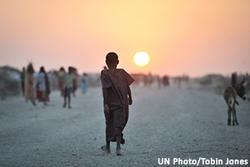 Note: This blog was written by guest blogger Yasin Ahmed Ismail. Yasin is a field researcher based in Nairobi, Kenya.
Note: This blog was written by guest blogger Yasin Ahmed Ismail. Yasin is a field researcher based in Nairobi, Kenya.
For the third consecutive year, the Horn of Africa is facing one of the most severe droughts in 70 years. The current crisis is a part of what a senior U.N. official has described as the “worst humanitarian crisis” since the U.N. was created. According to the U.N. Office for the Coordination of Humanitarian Affairs, more than 12.8 million people across the region are at risk of starvation. While most countries in the region have thus far averted a full blown famine, six million Somalis are acutely food insecure, while three million are in the “crisis” or “emergency” phases of food insecurity.
When the region faced a similar drought six years ago, Somalia was the only country to suffer from a famine. Today, we can see the same tell-tale signs of the 2011 famine which resulted in over a quarter million deaths: rising water and food prices, increasing number of cholera-related deaths, declining prices and depletion of livestock, and an increasing population of internally displaced in makeshift camps. Witnessing this tragic history repeat itself before our eyes leads to the question: why is Somalia seemingly more susceptible to famine than its regional neighbors?
Droughts are common in the Horn of Africa. Despite their increasing frequency over the last few decades, the region has dealt with these climatic phenomena for centuries. However, rarely does a drought itself cause a famine – more often than not, famine is the result of human action or the lack thereof. While the drought played a precursory role, the 2011 Somali famine was solely a human-made catastrophe driven by conflict.
Over 260,000 people – approximately half of them children – died in 2011 as a result of several related factors: conflict between the Transitional Federal Government (TFG) and al-Shabaab, lack of response to early warnings, rampant corruption in the TFG, U.S. government restrictions on food aid designed to prevent al-Shabaab from inadvertently receiving assistance, and al-Shabaab denying aid from reaching those in need. Neighboring Kenya and Ethiopia both managed to prevent the same 2011 droughts from spiraling into human-made catastrophes.
Today, Kenya and Ethiopia are averting famine by taking a number of steps such as contributing millions of dollars to their respective relief efforts, providing drought-resistant seeds and animal feed to farmers and pastoralists in arid and semi-arid areas, and offering cash payouts to pastoralists facing dwindling livestock numbers. Of course, Kenya and Ethiopia are by no means the gold standard – both countries have also been slow in their early response. However, over the last few months they have accelerated their efforts as the drought worsened. Their relative success shows that Somalia’s inability to avert famine can be attributed to three interrelated factors: immature governmental institutions, limited security, and vulnerable food production capacity.
Since 2011, Somalia has reached some significant milestones. Al-Shabaab, an al-Qaeda linked group that once controlled much of the country, has been relegated primarily to rural south-central Somalia. A transitional government phase came to an end with the selection of a permanent federal government in 2012, and earlier this year Somalis inaugurated a new government through a peaceful transfer of power. Even though most Somalis are rightfully proud of this progress, Somalia is still in the post conflict rebuilding phase.
Unlike the Kenyan and Ethiopian governments, the Somali government and its institutions are weak, and thus the government’s ability to respond to droughts and deliver aid is extremely limited. The Somali government did not raise enough alarm as the drought intensified over the last two years. One sign of this continued Somali government weakness: millions are still living in deplorable conditions inside internally displaced camps on the outskirts of major cities.
Moreover, al-Shabaab is still a potent threat with the ability to launch mass-causality attacks. Besides those in northern Somalia, a majority of drought-affected Somalis are from the same rural areas where al-Shabaab operates. While the group’s strong opposition to aid has diminished due to the backlash against their 2011 no-aid policy, al-Shabaab is still known to actively target humanitarian organizations. Recently, the terror group attacked an Emirates Red Crescent food convoy as it attempted to deliver aid in Mogadishu. The security threat from al-Shabaab continues to hinder the ability of humanitarian organization to provide lifesaving aid exacerbating the situation further.
Furthermore, the supply of food products is quite vulnerable to climatic conditions. Unlike Ethiopia and Kenya, the majority of Somalis are nomadic and farming is not as widespread. Except for the production of mostly rain-fed cereals in south-central and parts of north-west Somalia, the majority of food consumed in the country, including rice and other grains, is imported. Thus, during a severe drought most Somalis lose their livestock, which serve as both a main source of livelihood and the country’s primary export. The remaining livestock fetch lower prices due to poor body conditions, while local produce such as cereals and imported food become more expensive. Kenya, in contrast, has a more mature agricultural sector that ensures a level of food security, even for those who are dependent on livestock.
The international community needs to immediately mobilize additional aid to stabilize the deadly conditions inside Somalia and then concentrate on rebuilding state institutions through sustainable development solutions. This includes funding high impact development infrastructure projects, rebuilding Somalia’s fishing industry to counter the scarcity of local food production, and providing technical assistance on good governance with zero tolerance for corruption. It also requires rebuilding and modernizing a national security apparatus capable of targeting al-Shabaab and multi-national illegal fishers. Although no one can prevent a drought, Somalia can put itself in a better position to tackle the negative effects of these droughts and end its repeated cycle of famine.
Photo: Jowhar IDP camp in Somalia, December 2013.

